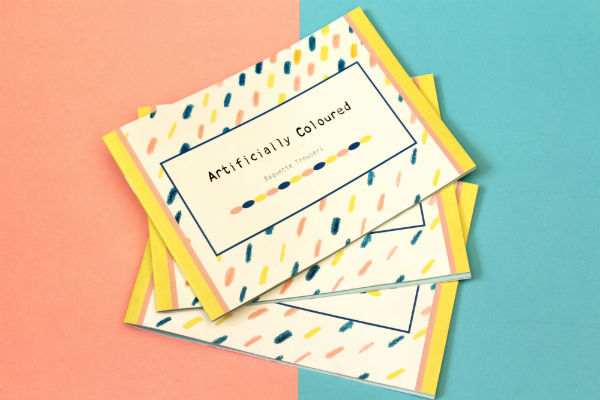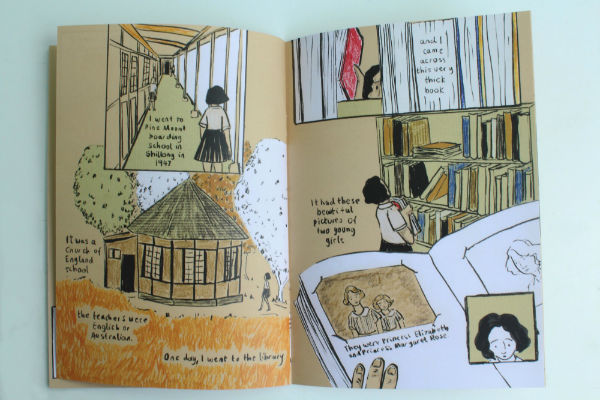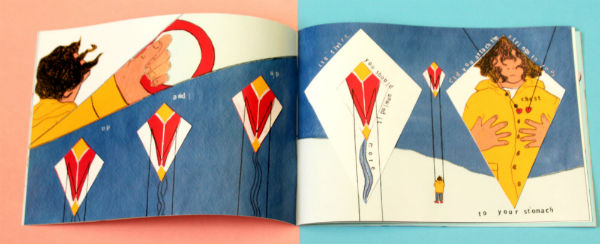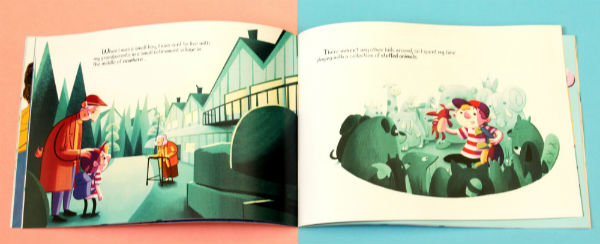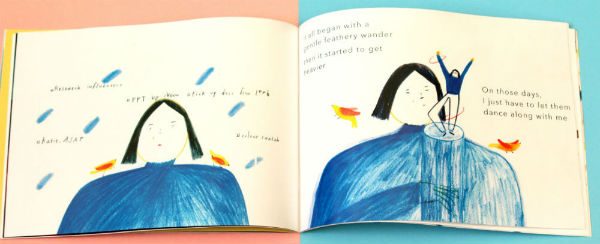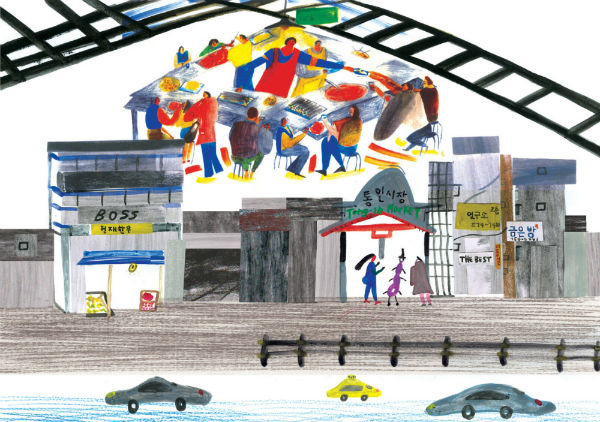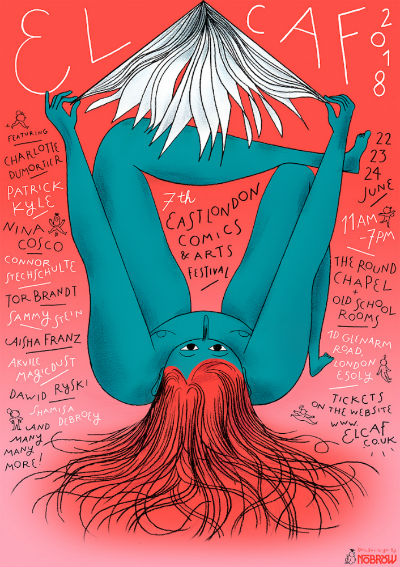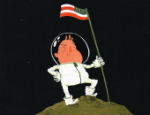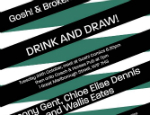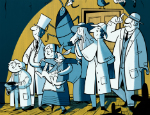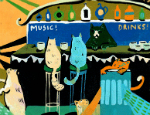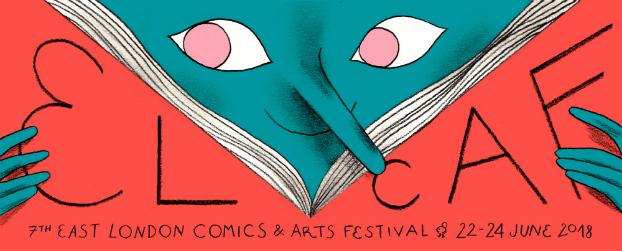
ELCAF FORTNIGHT!
Baguette Trousers comprises three up-and-coming artists – Chloe Elise Dennis, Luke Finch and Sinae Carrotate Park – whose varied visual styles and practice can be seen as a collective for the first time at this month’s East London Comics and Arts Festival.
I first met Chloe last year at the ELCAF Springboard Meetings when I had the opportunity to give her feedback on her portfolio so it’s wonderful to be able to speak to her today about how far she’s come in that time and also to chat with two equally exciting new creative voices in Luke Finch and Sinae Carrotate Park. I talk to the trio about the origin of their distinctive name, their ELCAF debut anthology Artificially Coloured, and the supportive advantages of working as a collective…
ANDY OLIVER: Could you all briefly introduce yourselves and tell us a little bit about your artistic backgrounds?
CHLOE ELISE DENNIS: I’m Chloe, at the moment I consider myself an illustrator and comics creator. I’ve pretty much always wanted to write and draw. Last year I graduated from an Illustration BA which I spent the last year of focusing on making comics. Since then I’ve been trying to balance working full-time with creating work.
LUKE FINCH: I’m Luke, a self-taught cartoonist and writer with a particular focus on visual storytelling. As I didn’t have the opportunity to attend university, I’ve had to learn what I can from the crumbs of knowledge scattered around in books and online. Animals are a common theme in my work, though I’m not sure why.
SINAE CARROTATE PARK: I am an illustrator living in Norwich where I study illustration. In my final year of an English Literature degree, I took a short course in graphics and illustration in London and that’s how it all started. I am interested in metaphors of objects, and encounters from everyday life.
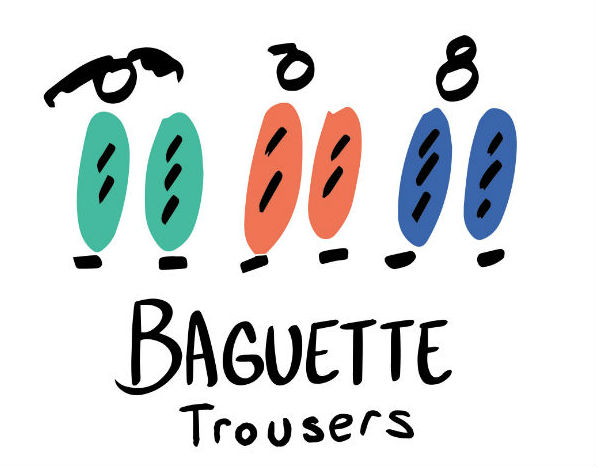
AO: Your individual styles are all very different. How did Baguette Trousers came into being as a collective? How did you all initially meet?
CHLOE: Sinae and I were on the same course at university two years apart and Sinae and Luke were already friends. The first time the three of us were in one place was at a talk about comics in Norwich by Stephen Collins and Hannah Berry, so that was how we realised we all had similar interests. Sinae and I kept in touch over Instagram and talked about collaborating. We decided to table together at a Christmas Illustration fair in December 2017, at which point Luke joined. We enjoyed doing it, so decided to formally be a collective and apply for ELCAF.
AO: What’s the story behind the name Baguette Trousers?
SINAE: Honestly, it came from a slightly odd ritual that my friend and I created. We usually get a baguette with goat cheese whenever we attend an event together. It was a coincidence that we got some the day we talked about the name of our collaboration and when we were brainstorming for a name for our collective, it struck me that my sack-like trousers reminded me of baguettes. The others found the juxtaposition between two words funny so we stuck with that.
CHLOE: It seemed really random, but it seemed to fit and I can’t really imagine us being called anything else now.
LUKE: I think it was supposed to be a placeholder name, but we grew fond of it.
AO: What are the advantages of banding as a collective in promoting your work? How much does collaboration and support of each other’s practice play a role in the aims of the collective?
ALL: Practically it keeps costs down when exhibiting at places such as ELCAF. We’re doing all 3 days and financially it would be a bit much to do that as an individual just starting out. On the work side of things, it’s a chance to bounce ideas off other people and see different ways of working. It’s good to know that you’re not alone. We’re all honest with each other, which helps get through the ups and downs. We keep coming back to the idea of the collective as a space for experimentation, which is a good way to view our aim.
AO: You have a collective anthology Artificially Coloured debuting at ELCAF. What is the central theme of that comic?
SINAE: The theme of childhood objects came organically from my personal project where I explored food as a metaphorical object. As we discussed topics for collaboration project, I thought it would be an interesting topic since we would all present different but equally interesting perspectives on childhood objects. We found that despite our backgrounds being all very different and unique, the sentiments are quite similar in a way.
AO: Chloe, last year you were taking part in the ELCAF Springboard Meetings, getting feedback on your work from publishers. How does it feel to be exhibiting at ELCAF just one year later? And how much do you feel your work has developed in the past twelve months?
CHLOE: It feels exciting and quite surreal, I’d always imagined it taking a few tries to exhibit at ELCAF. I think I would be pretty overwhelmed if I wasn’t exhibiting with friends. I’ve only done a couple of smaller fairs in the past, so this feels like quite a step up, but it’s been really motivational. I feel like my work’s come a long way in a year. I’ve been experimenting more with style and storytelling, it feels like I’m getting closer to what I want my work to be, although I haven’t quite figured out what that even is yet!
AO: The first work we reviewed at Broken Frontier from you was Every Hour is Saved (above). What was the genesis of that slice-of-life offering?
CHLOE: Well, it was basically my final project at university. I’d decided a year earlier that my dissertation and final project was going to be about autobiographical and biographical comics. I’d always wanted to talk to my Grandma properly about her childhood in India and subsequent migration to England so this seemed like a good excuse to finally do it! She’s been telling me bits and pieces all my life, some of the best stories didn’t make it into Every Hour is Saved due it being so short, there’s a great one about an orphanage and chickens on a train. I hope one day I can go back and do it properly.
AO: You have a new comic debuting at ELCAF. What are the central themes of Written in Water?
CHLOE: It‘s hard for me to say concisely, it’s mostly about how difficult and complex childhood friendships can be, the power imbalances that occur, and how the things that happen then echo through our lives. I’m very haunted still by experiences I had with my peers when I was the age the characters are, so in a way this was a bit of an exorcism for me. I think of it as a ghost story in a way, but I’d be curious about how other people interpret it.
AO: ‘Unwind’, your story in Artificially Coloured (above), is a beautifully paced, almost poetic, remembrance of childhood. Why did you choose to focus on those particular memories for the anthology?
CHLOE: Wow, I’m just realising both my new things for ELCAF are sad, childhood things. When we set the theme of childhood objects I was really struggling the come up with something. Then I saw the object that the story is about in my house one day and all the emotions and anxiety came flooding back. It was such a strong reaction that I felt it was the story I had to tell. Sinae and Lukes’ stories are happier, I promise!
AO: Luke, your comics have a very clear line and accessible cartooning style. Can you elaborate on your creative process for us?
LUKE: As my background is in writing, I tend to start projects by freewriting and brainstorming in a notebook until it’s clear to me what the story is about, who the characters are, and where the major story points fall. Ideally, I would write the whole thing out first either as a script or in prose form before picking up a pencil, but I’m impatient and usually skip ahead before I’m ready.
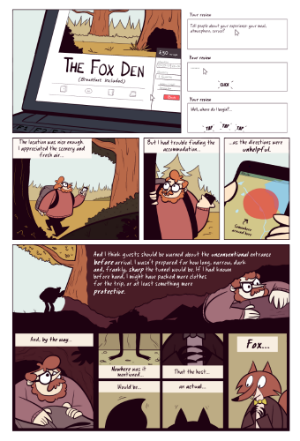 The doodling phase is the most enjoyable part of any project, so I try to prolong it for as long as possible before I have to do the tedious drawing and inking. I usually explore the visual aspects of the story in a sketchbook, first finding shapes which represent each of the characters (triangles, oblongs, elegant lamp shades, etc), and then designing the characters and exploring their attitudes and gestures in unrelated ‘story sketches’ – these are small scribbles of the characters interacting with each other, the environment or objects. Then I plan the whole story out in thumbnail form – this is the most important part of the process as it helps me figure out the composition of the panels. I try to make the character’s actions and the staging read as clearly as possible, so I usually spend a lot of time playing around with the thumbnails until I get them right.
The doodling phase is the most enjoyable part of any project, so I try to prolong it for as long as possible before I have to do the tedious drawing and inking. I usually explore the visual aspects of the story in a sketchbook, first finding shapes which represent each of the characters (triangles, oblongs, elegant lamp shades, etc), and then designing the characters and exploring their attitudes and gestures in unrelated ‘story sketches’ – these are small scribbles of the characters interacting with each other, the environment or objects. Then I plan the whole story out in thumbnail form – this is the most important part of the process as it helps me figure out the composition of the panels. I try to make the character’s actions and the staging read as clearly as possible, so I usually spend a lot of time playing around with the thumbnails until I get them right.
Then I do very rough drawings (usually just the shapes of the characters and backgrounds), sometimes on paper, sometimes on the computer, and then ink and colour digitally in Clip Studio – though I’m looking forward to using gouache and watercolour for my next project.
AO: Can you give us some background on your story ‘Stuffed News’ in Artificially Coloured (below) and why you opted to mix personal experience and fiction for your contribution to the anthology?
LUKE: The theme we chose for the book, childhood objects, was a bit of a challenge for me since I don’t have any particular attachment to objects from my childhood. I spent a long time mulling it over and eventually thought about the collection of stuffed animals I had taking over my bed – I collected so many that I barely had any room to sleep. That’s interesting, maybe, but not interesting enough for a story. Then, while thinking about some of the animals that stood out in my memory – Torty, the tortoise, Snowy the polar bear, Squeaks, the squeak toy crocodile and a knocked-off Yogi Bear called Mr Edd (I haven’t gotten any better at choosing names) – I started to remember how I used them as actors in stories and news broadcasts that I recorded on one of my grandfather’s old tape recorders. Yes! I thought, leaping off my chair, this is it! This is the story that I will contribute to Artificially Coloured!
But how would I tell this story? I had already decided beforehand that I would contribute a fictional story and have a character play my part – this was for two reasons: the first being that I’m most comfortable working in fiction, and the second being my crippling discomfort with being in the spotlight and talking about my personal experiences, even in the form of a picture book. I wondered: what if this childhood game encouraged me to go after a career in news reading? How would I feel reflecting on this memory when I was on the verge of retirement? From that thought came both the character that appears – the alternate, news-reading me – and the structure for the story. I, of course, also changed the names and appearances of the stuffed animals to protect their identities.
AO: Sinae, you have an engaging visual style that instantly catches the eye and brings the reader into events. Can you tell us about the different mediums that you work in and your wider practice?
SINAE: I am really glad that my work is read in that way! I recently realised that I am sensitive to gestural and suggestive depiction sof the scene. I think that carries through other things that I do whether that happens to be writing, publications, or ceramics.
I have natural tendencies towards metaphors of everyday encounters. Those things are easily blended in but, I think, they can speak about something bigger like social constructs and relationships that we have in society. For example, I am interested in the metaphors of food such as in how when, who, and where the food is consumed can speak a lot about our society.
My background in literature has trained me to approach each project with a balance of writing and illustrations and, I think, reading and writing, even when I don’t have ideas for projects, keep me inspired for future projects. Making ceramics is the most loose part of my practice because I tend to only focus decisions on colour, form and the gesture of the objects and I think it really helps me balance between conviviality and thematic approach in my work.
AO: Your story in Artificially Coloured works so well because it’s less about narrative and more about communicating an experience. What is the premise of ‘Excellent’ and how did you go about recapturing a moment of time in those pages?
SINAE: My work experience at a publishing house, which was 9-5 fixed working hours, made me empathise with others who work in ‘regular hours’. I was quickly assimilated and I thought about work even when I was not working. So, through my story, I wanted to suggest escaping to a sweetest moment in the past which for me was when I could devour numbers of ‘Excellent’ [ice cream] in the hot summer.
I feel that the way I went about with this project was quite different from others in the sense that I didn’t even have scripts or words at first, but I just had visual imageries for the different slots of pages. Visuals came first and then the writing came to fill some gaps for clarifications. Also I intentionally left watermarks and some pencil smudges from the process because I think the sensitivity of marks can be communicated on their own.
AO: And, finally, what’s next for you all, both as a collective and as individual artists? What projects and appearances can we expect from you in the near future?
ALL: We’d love to do another volume of Artificially Coloured, we’ve already been discussing the theme for the next one. It’s a chance for us to play around and challenge each other. Individually, we’re working on a range of things, such as comics, illustrations and collaborations with different individuals and organisations. For upcoming appearances, we will be at PROCESS! Festival at Somerset House on the 21st July, and hopefully a couple more fairs throughout the year.
Baguette Trousers will be exhibiting at ELCAF. You can visit their website here which has links to the individual sites of Chloe, Luke and Sinae. You can also follow them on Twitter here.
For regular updates on all things small press follow Andy Oliver on Twitter here.
Catch up on all our ELCAF Fortnight articles to date here. ELCAF runs from June 22nd-24th. Full details on the ELCAF site here and you can also follow the festival on Twitter here.





